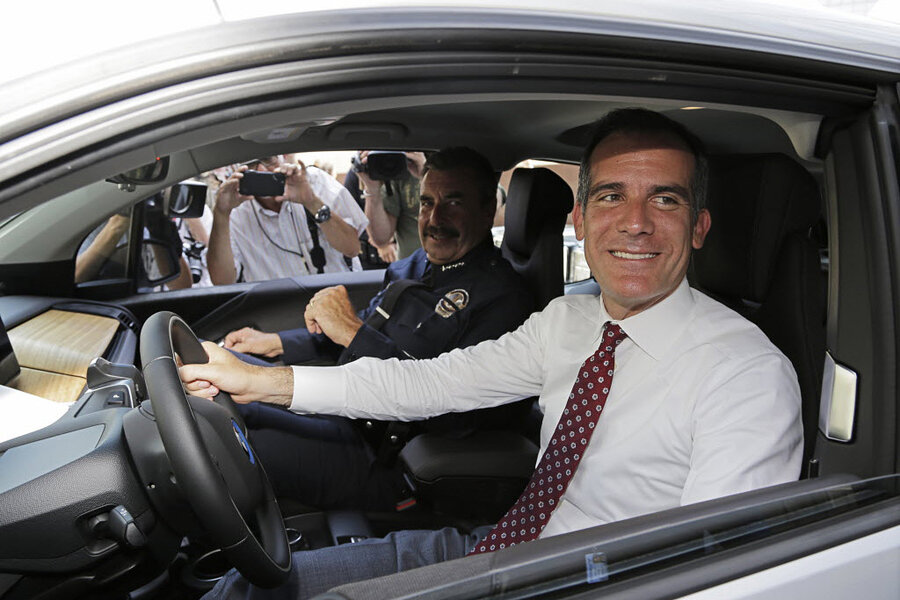LA police commit to a greener future with electric cop cars, even a Tesla
Loading...
Moving forward with a vision to make Los Angeles a more sustainable city and perhaps reduce its infamous smog, Mayor Eric Garcetti revealed on Friday that the city will begin leasing a raft of electric cars, including 160 fully-battery powered vehicles, for use primarily by the Los Angeles Police Department.
The move, announced on a sweltering day outside police headquarters, will give the city the largest number of purely electric vehicles in the country, Mr. Garcetti said. Describing electric cars as “the future,” he said the new vehicles made sense for environmental and economic reasons.
“Our goal is to one day go from gas-powered to battery electric in our squad cars. And if we do that, the impact could be national in scale. LA could once again the lead the way to help transform not just our department, but other departments and cities around the country,” Garcetti said at Friday’s announcement, according to the Los Angeles Times.
The city will also add 128 plug-in hybrid cars, along with a loaned Tesla Model S P85D and BMW i, which the mayor showcased on Friday. One hundred vehicles will be used exclusively by the police department, shared among detectives, investigators, and administrative employees, the mayor’s office said in a statement.
It’s still unclear how the police department will actually use the new electric vehicles. Some sources have suggested (with various levels of seriousness) that the cars’ nearly silent engines could be an advantage for police hoping to catch a crime in progress. Observers on Twitter have pointed out that the Tesla – which can accelerate from 0 to 60 miles per hour in 3.2 seconds, a feature the company calls “insane mode” – could be used to chase fleeing suspects:
While Mayor Garcetti did suggest that the new cars were “quick” and “quiet enough to sneak up on someone,” on Friday – which prompted a smile from Police Chief Charlie Beck, according to the Times – the city’s official explanation about how the police will use the expensive loaner vehicles is more benign.
“These vehicles will be used for testing and research by LAPD technical experts to determine how this technology can support their future needs,” the mayor's office said in the statement.
The department’s purchase comes on the heels of an ambitious citywide environmental plan released earlier this year. Known as the Sustainable City pLAn, it aims to reduce greenhouse gas emissions by 80 percent by 2050 and eliminate the water and power department’s use of coal entirely by 2035.
Charging the new vehicles may prove to be a concern, partly because of the environmental impact of using electricity generated by traditional coal-based plants as opposed to less widely-available wind and solar energy.
But in California, reliance on alternative energy sources such as wind power has been increasing over the past few years. Los Angeles has reduced its use of coal-fired electricity, which provided 40 percent of the city's power needs in 2010. As a result, according to a 2014 analysis by the Union of Concerned Scientists, driving in California with a fully electric car would be the equivalent of driving a gasoline car that gets 95 miles per gallon
But the report notes, gas-based cars typically have lower fuel economy, making electric and hybrid cars more efficient even if they are charged using electricity from coal-fired plants.
Los Angeles has been slowly building a fleet of electric vehicles over time, with the new cars joining 67 existing vehicles, including 23 electric scooters and three electric motorcycles previously purchased by the police department, according to the mayor’s office.
The 288 new vehicles will be shared by other city agencies, with the fully-electric vehicles leased by the Police, Fire, and General Services departments and the hybrid vehicles shared by the Water and Power Department and the General Services Department.
Mr. Beck, the police chief, said the department’s purchase will both save the city money – cutting the operating costs for police vehicles by 41 percent, to 21 cents a mile – and provide an example for other cities about the many uses for electric cars.
“I think that today, this announcement, will trickle across the nation as a challenge to other cities, other police departments, other fire departments to look at what you're doing and to take a step that makes a change for the positive," he said on Friday, according to the Times.
[Editor's note: The original version of this story misstated the impact of driving an electric car compared to one powered by gasoline. In California, the average fully electric car is on par with a gasoline car with 95 m.p.g.]





